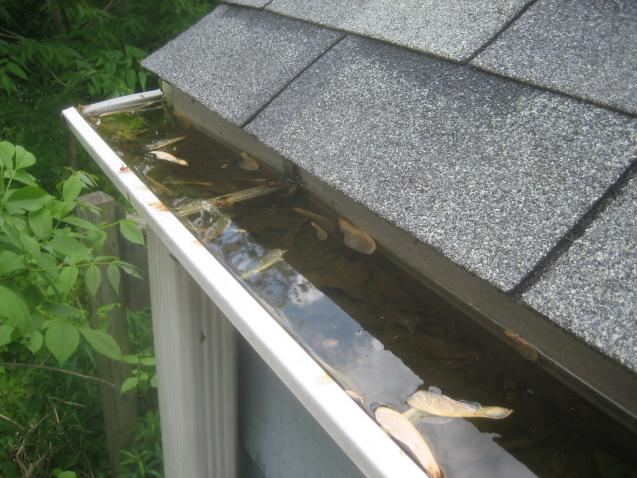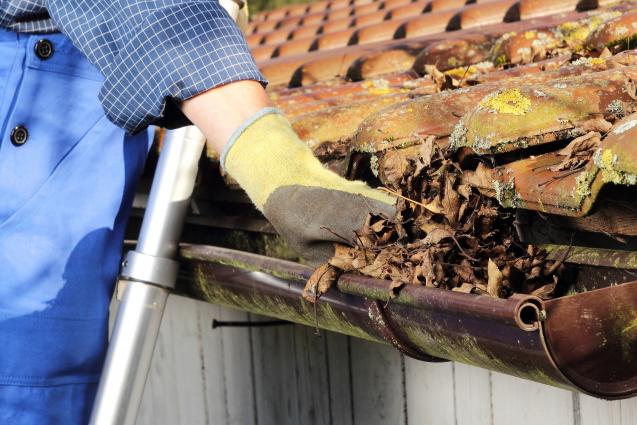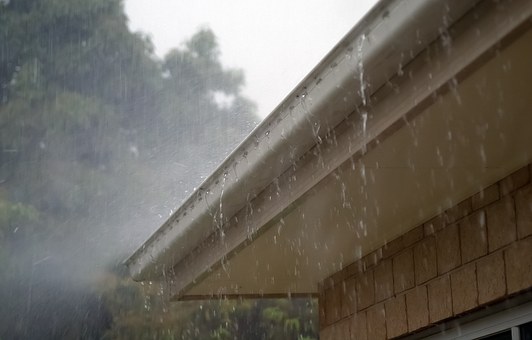
A Comprehensive Guide to Gutter Cleaning
By Porter Vac|November 27, 2018
A Comprehensive Guide to Gutter Cleaning
Cleaning out your gutter is not a glamorous task; you will likely get dirty and wet and will have to constantly move your ladder around. It is, however, very important for the weatherproofing and protection of your home and garden. Overflowing gutters can damage the roof, basement and even the structural integrity of the building’s foundations. Anything else beneath your guttering, such as a flowerbed, can also get destroyed.
It isn’t all bad news, though, as a little preventative medicine and regular maintenance can greatly reduce the difficulty of gutter cleaning so that you are ready for anything the elements throw at you. Gutter cleaning does not need to be difficult, although it can be dangerous if not tackled properly. This guide contains a number of tips to help you clean successfully and safely.
Schedule Regular Cleaning
Gutters need to be cleaned regularly, once a year is ok but biannual cleaning is ideal. If you check and clean them regularly, your gutters will be a lot easier to clean, making it a much less time-consuming chore. Clean gutters will slow down their rusting and help you avoid water damage to your paintwork, walls and doors. Going up ladders is not a safe task so it is recommended that you schedule their cleaning with a professional company; professional gutter cleaning companies will also know how best to clear debris and protect your home.
Ladder Safety
A ladder will be your primary tool for this task, although not just any ladder will do. Wooden ladders can become quite unsteady and therefore unsafe; aluminium or fibreglass ladders are recommended instead. A fibreglass ladder will be very sturdy, although if you have a large length of gutter to clean then you could end up getting fatigued moving it around so much, which will increase your chances of an accident. Although aluminium ladders don’t give quite as much support as fibreglass, they are most recommended for buildings with lots of guttering. Other ladder safety points that you should consider are:
· Always tell someone when you are going to work on a ladder.
· Ideally use a ladder with a shelf or hook so that you can carry a bucket with you for the debris.
· Check your ladder over for damage before use.
· Ensure all screws or bolts are tight and any mechanisms are locked in place before you climb the ladder.
· Ladder stabilisers are a good idea for extension ladders as they can reduce damage done to the gutter.
· Rubber shoes can give you much better grip on ladder steps and reduce your chances of slipping.
Personal Protection
You should be careful to protect your hands and eyes when cleaning your gutter to reduce your chances of injury. Cleaning a drainpipe can result in debris or animals, such as frogs, wasps and birds, shooting out and potentially damaging your eyes if they are not protected. Many things in your gutter can carry bacteria and disease, such as rotting leaves or animal droppings; gloves can protect you from bacteria as well as cuts from broken shards of gutter:
· Leather gloves are not advised, as they can be too thick and clumsy.
· Cotton gloves can absorb the water and bring bacteria into contact with your skin.
· Rubber gloves are good but don’t offer much protection from any sharp debris.
· Thick suede is the ideal material as it offers the best combination of protection and manoeuvrability.
Clean the Roof First
Before you start on the gutter you should clean the roof, otherwise as soon as it rains again all the leaves and debris will wash into the gutter. You should use a rake and a garden hose or pressure hose to wash off the loose debris. A garden hose with a pistol-grip nozzle is advised as you can hang it off the front edge of the gutter while you scoop out debris or move the ladder.
Gutter Scoop
Scooping debris out of the gutter with your hands is one of the best ways to clean it. A gutter scoop builds on this idea to make life even easier. Gutter scoops can be metal or plastic, but metal is not advised as you can further damage the gutter by scraping the bottom. A plastic scoop offers a very thin front edge to neatly fit in the gutter and pick up any debris.
Unclog Drainpipes
When cleaning the gutter, you should start at the drainpipe and move away so that you don’t clog them up while cleaning. Once all the gutters are clear, check the drainpipes for clogs, run your hose down them at full pressure and if the water backs up and overflows you have a clog. Usually, tapping the side of the drainpipe is enough to remove any clogs. If this doesn’t work you will need to remove it from the house and open it up.
Top Tips
· Use a safe ladder
· Clean the roof first
· Work away from the drainpipes
· Use a gutter scoop
· Flush the gutter with your hose after scooping out the large debris
· Wear proper protection
· Unclog drainpipes
Professional Gutter Cleaning Services
Professional services can remove any health risk to yourself, meanwhile cleaning your gutters in an effective and long-lasting manner that will most benefit the long-term health of your guttering. Contact us for free quote here.
Cleaning out your gutter is not a glamorous task; you will likely get dirty and wet and will have to constantly move your ladder around. It is, however, very important for the weatherproofing and protection of your home and garden. Overflowing gutters can damage the roof, basement and even the structural integrity of the building’s foundations. Anything else beneath your guttering, such as a flowerbed, can also get destroyed.
It isn’t all bad news, though, as a little preventative medicine and regular maintenance can greatly reduce the difficulty of gutter cleaning so that you are ready for anything the elements throw at you. Gutter cleaning does not need to be difficult, although it can be dangerous if not tackled properly. This guide contains a number of tips to help you clean successfully and safely.
Schedule Regular Cleaning
Gutters need to be cleaned regularly, once a year is ok but biannual cleaning is ideal. If you check and clean them regularly, your gutters will be a lot easier to clean, making it a much less time-consuming chore. Clean gutters will slow down their rusting and help you avoid water damage to your paintwork, walls and doors. Going up ladders is not a safe task so it is recommended that you schedule their cleaning with a professional company; professional gutter cleaning companies will also know how best to clear debris and protect your home.
Ladder Safety
A ladder will be your primary tool for this task, although not just any ladder will do. Wooden ladders can become quite unsteady and therefore unsafe; aluminium or fibreglass ladders are recommended instead. A fibreglass ladder will be very sturdy, although if you have a large length of gutter to clean then you could end up getting fatigued moving it around so much, which will increase your chances of an accident. Although aluminium ladders don’t give quite as much support as fibreglass, they are most recommended for buildings with lots of guttering. Other ladder safety points that you should consider are:
· Always tell someone when you are going to work on a ladder.
· Ideally use a ladder with a shelf or hook so that you can carry a bucket with you for the debris.
· Check your ladder over for damage before use.
· Ensure all screws or bolts are tight and any mechanisms are locked in place before you climb the ladder.
· Ladder stabilisers are a good idea for extension ladders as they can reduce damage done to the gutter.
· Rubber shoes can give you much better grip on ladder steps and reduce your chances of slipping.
Personal Protection
You should be careful to protect your hands and eyes when cleaning your gutter to reduce your chances of injury. Cleaning a drainpipe can result in debris or animals, such as frogs, wasps and birds, shooting out and potentially damaging your eyes if they are not protected. Many things in your gutter can carry bacteria and disease, such as rotting leaves or animal droppings; gloves can protect you from bacteria as well as cuts from broken shards of gutter:
· Leather gloves are not advised, as they can be too thick and clumsy.
· Cotton gloves can absorb the water and bring bacteria into contact with your skin.
· Rubber gloves are good but don’t offer much protection from any sharp debris.
· Thick suede is the ideal material as it offers the best combination of protection and manoeuvrability.
Clean the Roof First
Before you start on the gutter you should clean the roof, otherwise as soon as it rains again all the leaves and debris will wash into the gutter. You should use a rake and a garden hose or pressure hose to wash off the loose debris. A garden hose with a pistol-grip nozzle is advised as you can hang it off the front edge of the gutter while you scoop out debris or move the ladder.
Gutter Scoop
Scooping debris out of the gutter with your hands is one of the best ways to clean it. A gutter scoop builds on this idea to make life even easier. Gutter scoops can be metal or plastic, but metal is not advised as you can further damage the gutter by scraping the bottom. A plastic scoop offers a very thin front edge to neatly fit in the gutter and pick up any debris.
Unclog Drainpipes
When cleaning the gutter, you should start at the drainpipe and move away so that you don’t clog them up while cleaning. Once all the gutters are clear, check the drainpipes for clogs, run your hose down them at full pressure and if the water backs up and overflows you have a clog. Usually, tapping the side of the drainpipe is enough to remove any clogs. If this doesn’t work you will need to remove it from the house and open it up.
Top Tips
· Use a safe ladder
· Clean the roof first
· Work away from the drainpipes
· Use a gutter scoop
· Flush the gutter with your hose after scooping out the large debris
· Wear proper protection
· Unclog drainpipes
Professional Gutter Cleaning Services
Professional services can remove any health risk to yourself, meanwhile cleaning your gutters in an effective and long-lasting manner that will most benefit the long-term health of your guttering. Contact us for free quote here.



